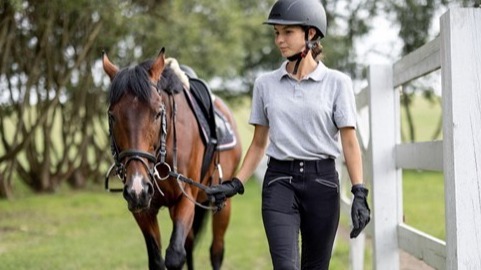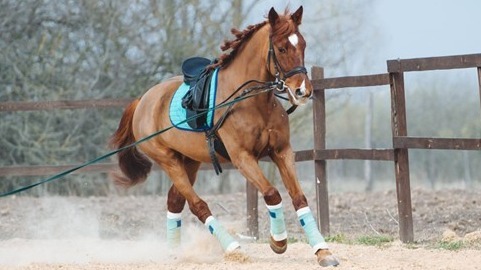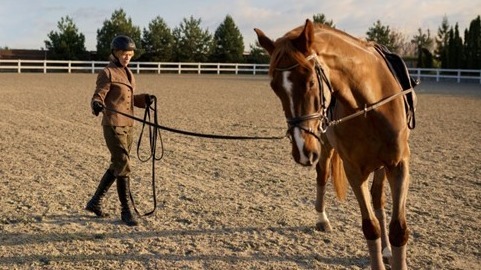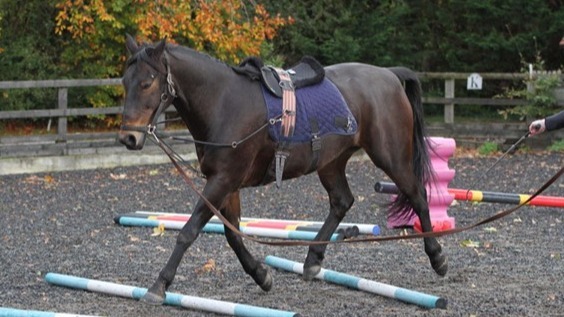The best in-hand exercises for horses

No horse training regime is complete without some in-hand work. This is when you train your horse from the ground, using a head collar and lunge line or lead rope, rather than riding them from the saddle.
In-hand work is a great way to introduce your horse to an exercise without the added pressure of having a rider on their back — they’ll find it much easier to move through their back and core without the weight of a saddle and rider. It’s also perfect for training your horse if it can’t take the saddle for any reason, for example, if you’re bringing your horse back to work after a break or injury. Working in hand also offers the opportunity to view your horse’s form from the ground, offering a better view of how they move through each exercise.
In-hand exercises can be particularly useful for strength training and for developing suppleness in your horse’s body, as well as for training for more specific disciplines, such as dressage and jumping. Here, we’ll be going through some of the best in-hand exercises for horses and offering our tips for doing them effectively.
- Preparing for in-hand work
- Teaching your horse to halt
- In-hand exercises for strength
- Backing up
- Raised pole exercises
- In-hand exercises for suppleness
- Lateral work
- Carrot stretches
- In-hand exercises for balance
- Turning on the forehand
- In-hand exercises for obstacles
Preparing for in-hand work

Even when you’re working from the ground, safety should still be your utmost priority, so a riding hat and gloves are a must. A long lead rope or lunge line is also important. A line of at least six metres should be enough. This way, if the horse spooks, you can let the line out and keep a safe distance away.
Before doing any in-hand exercises, it’s also important that your horse is relaxed and able to respond to basic commands. A relaxed horse will be much more responsive and will be able to learn much faster than they would if they were feeling anxious. In episode two of our series Burto’s Basics, horse trainer Connie Colfox shares her tips for keeping your horse relaxed in preparation for training.
When working in hand, you won’t be able the same body commands to ask your horse to do something as when riding, so you’ll need to get your horse to respond to voice commands and pressure on the lead rope to be able to work effectively. You will need to be able to ask your horse to stand still and walk on with precision.
Teaching your horse to halt
Teaching your horse to halt when asked may sound simple, but some horses will be inclined to take a small step forward while standing. To stop this, you’ll want to stand still, some distance from your horse, and turn towards them. As they take a step, wiggle the lead rope from side to side to ask your horse to step backwards, rewarding them for responding correctly. In season one, episode one of Listening to Horses, Annemarie van der Toorn shares her tips for teaching your horse to halt when asked.
Once they’ve got the hang of halting correctly you can start incorporating voice commands until your horse is able to stand still using just a cluck. In episode one of our series Burto’s Basics, Olympic eventer Chris Burton offers his advice for getting a horse to react to your voice. As with any training regime, repetition is key, so keep practising a halt-to-walk and walk-to-halt until you feel your horse can do this with minimal effort.
In-hand exercises for suppleness

A supple horse is essential for any style of riding as ensuring full flexibility in your horse’s joints will help with balance and straightness. Many horses can have stiffness in one side of their body, and this is entirely natural, but if you’ve noticed that your horse tends to lean left or right then you’ll need to work to make the muscles on either side loose and flexible. If you’re looking to improve your horse’s suppleness, there are a few in-hand exercises you can try.
Lateral work
Lateral work is one of the most basic in-hand exercises for horses and encourages the horse to step under their body with the inside hind leg, improving strength, suppleness, and collection. To introduce your horse to lateral work, stand to their side towards their head and gently touch their flank with your whip as you take a step towards them. Make sure to apply a small amount of pressure to the lead rope as you do so to stop your horse from moving forward.
Allow your horse to take a few steps before halting and moving onto the other side. When doing this exercise, it’s important not to push your horse to do too many steps at once. Start with just a few steps at first until your horse becomes more confident with the exercise.
Carrot stretches
Carrot stretches can be done from a halt and use the horse’s natural movement to stretch their muscles, improve flexibility, and build core strength. This exercise can be done upwards and downwards, and side to side, and can help with rounding, stretching, and lateral movement. When doing this exercise, you’ll use a carrot or any other form of treat to entice your horse to move their head in a certain direction.
Before starting carrot stretches, you’ll first want to make sure your horse is on a flat surface and standing square. You may need to move their legs slightly until they’re standing correctly.
The first exercise is called a bowing stretch and stretches the poll area as well as muscles in the base of the neck and the back. To do this, hold a carrot between your horse’s front legs to encourage them to stretch their neck towards their chest and then down towards their knee. Hold each stretch for 10 seconds before releasing. As your horse becomes more flexible, you’ll be able to extend the stretch further towards their fetlocks.
Next, you’ll want to stretch their neck to the side. Stand by the horse’s shoulder and, using the carrot, encourage them to stretch their head towards their girth. Hold this position for 10 seconds before letting them relax and moving onto the other side.
The final carrot stretch you can do with your horse is an extension exercise. Stand facing the horse and hold the carrot upwards to encourage them to extend their neck. Again, hold this position for 10 seconds before letting them relax.
In-hand exercises for balance and strength

If your horse tends to fall out on circles or struggles to stay down the centre line, then they may need to develop their strength and balance. When doing any strength training exercises with horses, it’s usually most effective to do them in a walk rather than trot, as the horse is relying purely on muscular strength to move rather than being assisted by the momentum of a trot.
Backing up
A simple but effective in-hand exercise for horses, backing up helps to strengthen muscles, particularly in the hind end and sacroiliac area. Teaching your horse to back up well on command also forms the basis of good horsemanship, whether you’re asking them to step back into their stable, exit their trailer, or you’re training them for their first dressage test.
To do this exercise, bring your horse to a halt and apply light pressure to the chest and head collar to encourage your horse to walk backwards. Try to encourage them to keep their head low, as this will properly engage their hind muscles. Be sure not to rush your horse too. Between 10 and 20 slow and steady steps should be enough to properly work their muscles and build strength.
Turning on the forehand
If your horse is comfortable with lateral movement, you can incorporate the shoulders to teach your horse to turn on the forehand. Your horse will need to concentrate and find their balance to be able to cross their front legs. This exercise is also great for opening up their shoulders and improving flexibility.
To teach your horse to turn on the forehand, move towards their head so you’re standing in front of them. Ask them to walk but stay in front of your horse as they take each step to stop them from moving forwards. Your horse should start to step their foreleg under so their legs cross. To see this in action and to get even more training tips, take a look at the fourth instalment of Half Halt with Pammy Hutton.
Bear in mind that this exercise can take some time for your horse to get used to, so as with lateral work, start with just a few small steps and build up to a full circle as your horse gets more confident.
Raised pole exercises
Raised pole exercises can add extra strength training to your horse’s regime as they’ll need to engage their hindquarters and lengthen their stride to be able to step over each pole. The higher the poles, the more they’ll need to engage their hindquarters, making this a great in-hand exercise for horses that tend to lean on your hands too much as you ride. You can read our guide to pole work exercises to find out how to do raised poles effectively, plus get some tips for the best raised pole patterns.
In-hand exercises for obstacles

Many horses can spook when they come into contact with obstacles such as jumps or ditches, but the good news is that you can try some in-hand exercises to develop their confidence in this area. These exercises are great when incorporated into your cross-country training regime, but you can also use them to get your horse used to various obstacles while hacking out.
Whether you’re training your horse for a competition or you’re looking to introduce your green horse to obstacles, be sure to watch our exclusive masterclass with top US rider Lauren Nicholson. In this series, you’ll learn essential in-hand exercises to help young horses get used to various cross-country obstacles, including jumps, ditches, and water.
Ditches can be particular sticking points for horses and riders, so if your horse is still having trouble in this area, check out episode three of our series Burto’s Basics for advice on helping your horse tackle ditches more confidently.
In-hand work can make the perfect addition to your horse’s training regime and these exercises will make great starting points when teaching new skills. For even more essential horsemanship advice, take a look at our exclusive series and shows, where you’ll find top training masterclasses such as Backstage Pass with Monty Roberts, Listening to Horses with Annemarie van der Toorn, and unmissable shows from Kelly Marks. Become a H&C+ member today to start watching.







